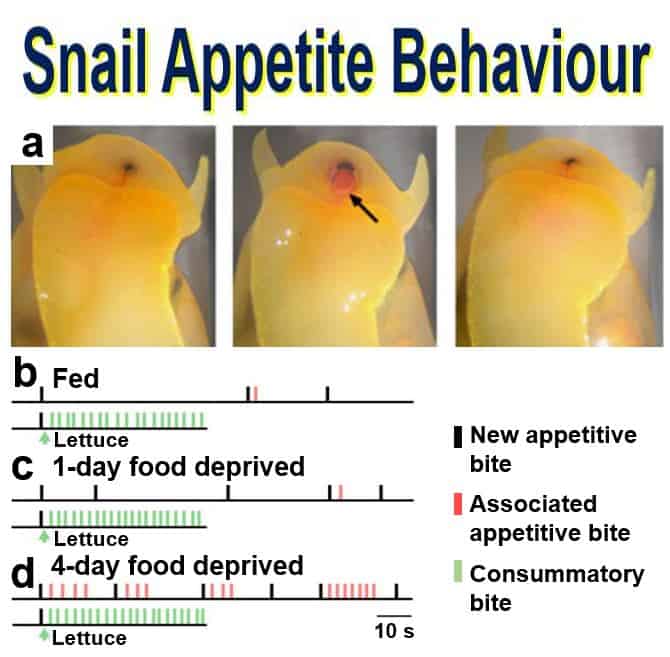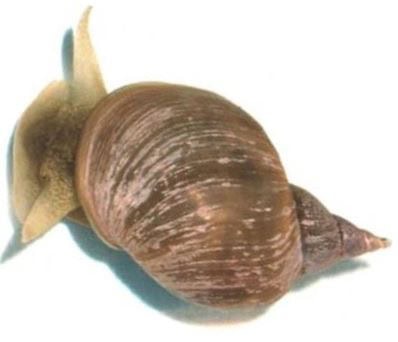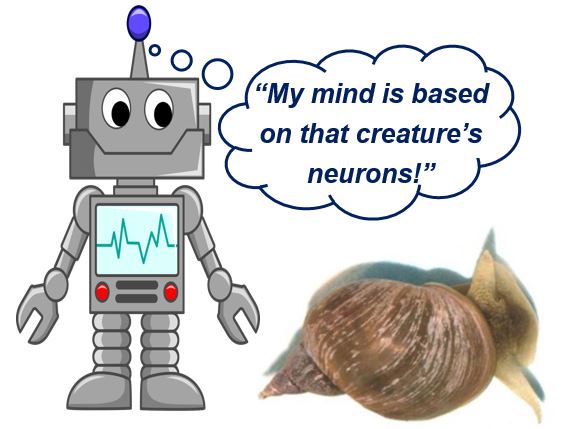Snails use just two neurons to make decisions, say scientists, who believe their findings should help engineers when designing the ‘brains’ of robots based on the principle of ultra efficiency – using the fewest possible components required to perform a complex task.
Michael Crossley, Kevin Staras and György Kemenes, all from the University of Sussex in England, explain in the prestigious journal Nature Communications how they discovered that just two neurons in the snail’s brain hold the key to explaining how complex behavioural decisions are made.
 Three images of freshwater snail’s (Lymaea’s) food-searching behaviour. (Frame 1) At water’s surface. (Frame 2) Appetitive bite behaviour with open mouth and protraction of toothed radula (see arrow). (Frame 3) Retration of radula. The same basic motor pattern is used for ingestion when food is present, for example, lettuce. (b-d) Example traces of freshwater snails biting behaviour in the presence and absence of food at 3 different levels of satiety. (Image: Adapted from Nature Communications)
Three images of freshwater snail’s (Lymaea’s) food-searching behaviour. (Frame 1) At water’s surface. (Frame 2) Appetitive bite behaviour with open mouth and protraction of toothed radula (see arrow). (Frame 3) Retration of radula. The same basic motor pattern is used for ingestion when food is present, for example, lettuce. (b-d) Example traces of freshwater snails biting behaviour in the presence and absence of food at 3 different levels of satiety. (Image: Adapted from Nature Communications)
Two neurons can make complex decisions
In what they claim is the first-of-its-kind study, the authors studied the brain activity of freshwater snails and discovered how a circuit consisting of just two neurons is capable of a sophisticated form of decision-making.
What is a robot?
The researchers, from Sussex Neuroscience, part of the university’s School of Life Sciences, gathered and analysed data on the snails’ behaviour when they made decisions in their search for lettuce.
They then measured brain activity by using electrodes to record tiny electrical changes – known as action potentials – in individual neurons.
 The Freshwater snail (Lymnaea stagnalis) uses just two neurons when making complex decisions. (Image: University of Sussex)
The Freshwater snail (Lymnaea stagnalis) uses just two neurons when making complex decisions. (Image: University of Sussex)
They discovered two types of neurons:
1. A control type of neuron which tells the snail’s brain that there is potential food nearby.
2. A second neuron that transmits signals informing the brain what its motivational state is – whether or not the animal is hungry.
An ultra-efficient system
The paper also explains how the system – created by neurons – enables the snail to save energy by minimising brain activity when no food is found.
Study leader, Professor of Neuroscience George Kemenes, said:
“What goes on in our brains when we make complex behavioural decisions and carry them out is poorly understood. Our study reveals for the first-time how just two neurons can create a mechanism in an animal’s brain which drives and optimizes complex decision making tasks.”
“It also shows how this system helps to manage how much energy they use once they have made a decision.”
 The discovery that snails solve complex decisions using only two brain cells could help engineers develop a super-energy-efficient robot brain.
The discovery that snails solve complex decisions using only two brain cells could help engineers develop a super-energy-efficient robot brain.
Learning from snails to design robot brains
The authors believe their findings may help scientists identify a number of core neuronal systems which underlie other similar decision-making processes. “This will eventually help us design the ‘brains’ of robots based on the principle of using the fewest possible components necessary to perform complex tasks,” Prof. Kemenes added.
Several goal-directed behaviours are necessary for animals to survive – food-searching is one of them. During an animal’s search for food, it has to integrate data about both its internal state and external environment in order to find food, while at the same time using as little energy as possible.
In an Abstract preceding the main paper in the journal, Prof. Kemenes et al wrote:
“Using an in vitro analogue of the decision-making process, we show that the system employs an energy management strategy, switching between a low- and high-use mode depending on the outcome of the decision.”
“Our study reveals a parsimonious mechanism that drives a complex decision-making process via regulation of levels of tonic inhibition and phasic excitation.”
Citation: “A two-neuron system for adaptive goal-directed decision-making in Lymnaea,” Michael Crossley, Kevin Staras and György Kemenes. Nature Communications 7, Article number: 11793. DOI:10.1038/ncomms11793.

Comments are closed.